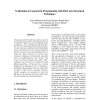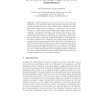TAGT
1998
Springer
13 years 9 months ago
1998
Springer
Reactive systems perform their tasks through interaction with their users or with other systems (as parts of a bigger system). An essential requirement for modeling such systems is...
ICSE
1998
IEEE-ACM
13 years 9 months ago
1998
IEEE-ACM
The design, implementation, and testing of virtual environments is complicated by the concurrency and realtime features of these systems. Therefore, the development of formal meth...
HASE
1998
IEEE
13 years 9 months ago
1998
IEEE
This paper deals with verification of flow control in concurrent programs. We use Ada language model as reference. After translation of Ada programs into Petri nets (named Ada net...
DATE
1998
IEEE
13 years 9 months ago
1998
IEEE
Petri nets are a graph-based formalism appropriate to model concurrentsystems such as asynchronouscircuits or network protocols. Symbolic techniques based on Binary Decision Diagr...
CONCUR
1999
Springer
13 years 9 months ago
1999
Springer
We present several interpretations of the behavior of P/T nets in terms of traces, event structures, and partial orders. Starting from results of Hoogers, Kleijn and Thiagarajan, w...
CONCUR
1999
Springer
13 years 9 months ago
1999
Springer
Abstract. The unfolding method, initially introduced for systems modelled by Petri nets, is applied to synchronous products of transition systems, a model introduced by Arnold [2]....
APN
1999
Springer
13 years 9 months ago
1999
Springer
: This paper examines how object-oriented extensions to the Petri Net formalism provide flexible structuring primitives which can aid the modelling of network protocols. A key bene...
CONCUR
2000
Springer
13 years 9 months ago
2000
Springer
Model checking based on the causal partial order semantics of Petri nets is an approach widely applied to cope with the state space explosion problem. One of the ways to exploit su...
AGENTCL
2000
Springer
13 years 9 months ago
2000
Springer
Conversations are a useful means of structuring communicative interactions among agents. The value of a conversation-based approach is largely determined by the conversational mod...
WOSP
2000
ACM
13 years 9 months ago
2000
ACM
This paper describes the software package DSPNexpress 2000, a tool for the quantitative evaluation of systems specified in stochastic Petri nets, the Unified Modeling Language (UM...


